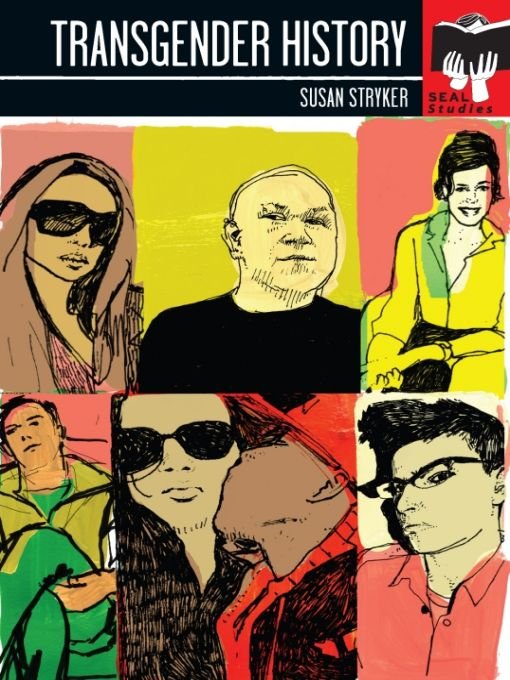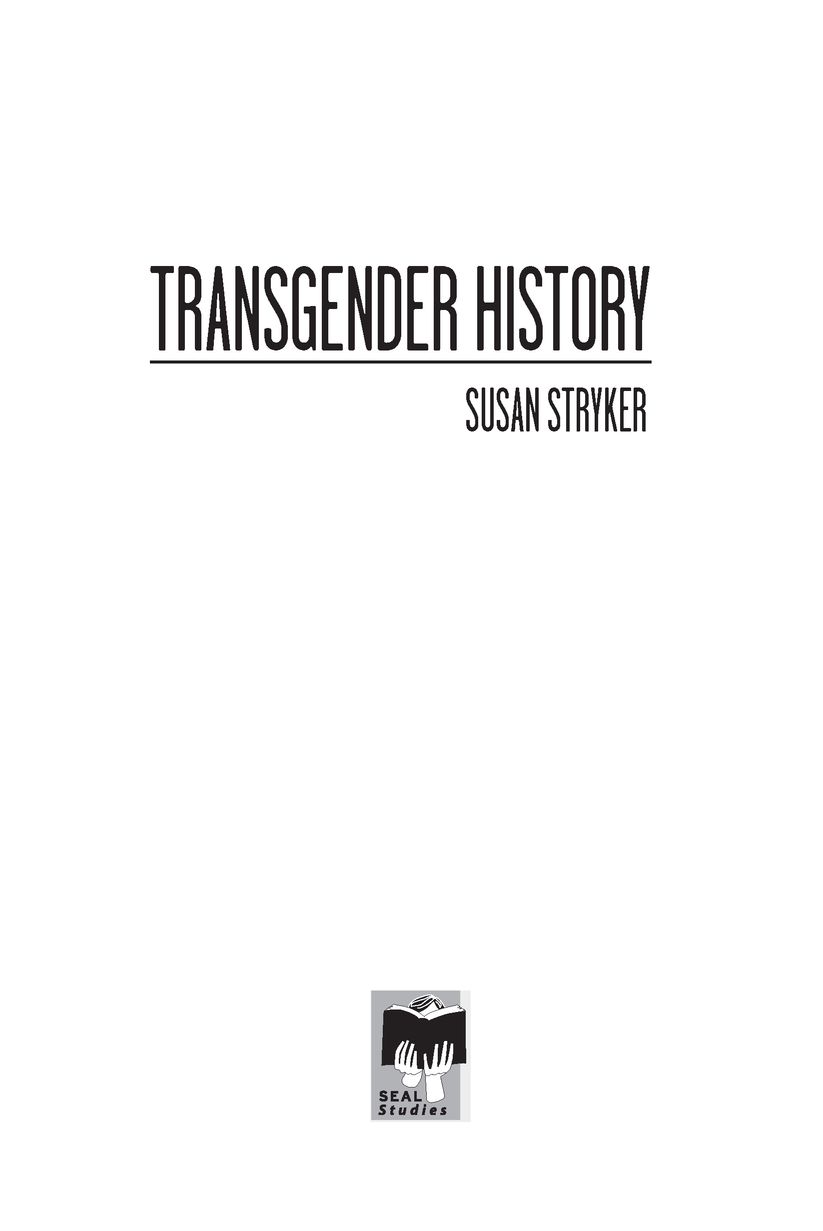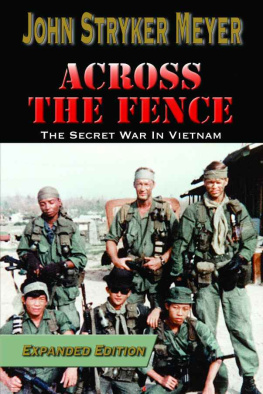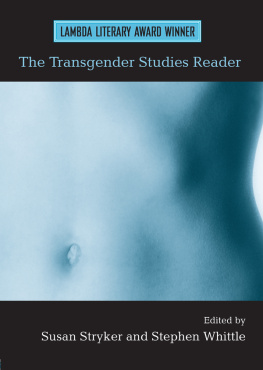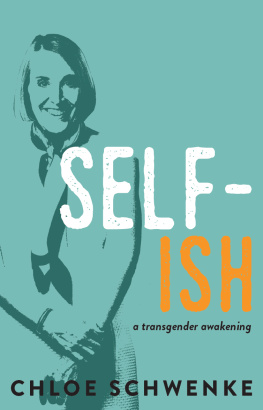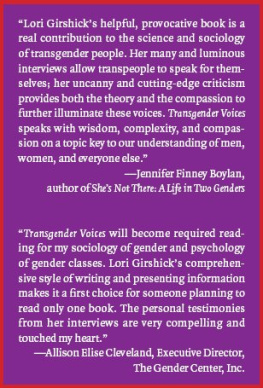Table of Contents
This book is dedicated to all the trans people who lived the lives that made the history Ive outlined here, and to the community activists, too numerous to mention, who continue to advance the cause of social justice for transgender people everywhere.
PROLOGUE
THE BRIEF HISTORY OF THE TRANSGENDER MOVEMENT in the United States presented in this book has a lot of personal significance for me. Piecing the story together has been the main focus of my professional life as a historian for nearly twenty years. But as a transsexual woman, Ive also been a participant in making that history, along with thousands of other people. What I have to say is colored by my own involvement in that movement, by my life experiences, and by the particular ways that I consider myself to be transgendered.
Im one of those people who, from earliest memory, always felt I was a girl even though I had a male body at birth and everybody considered me to be a boy. I didnt have an explanation for those feelings when I was younger, and after a lifetime of reflection and study Im still open-minded now about how best to explain them. I hid those feelings from absolutely everybody until I was in my late teens, and I didnt start coming out publicly as transgendered until the late 1980s, when I was almost thirty. Id never knowingly met another transgender person before that time.
I started living 24/7 as an openly transsexual lesbian woman in San Francisco in 1991-92, just as I was finishing up my PhD in United States history at the University of CaliforniaBerkeley. At the time, it wasnt a great career move, just something I needed to do for my own personal sense of well-being. As wonderful as it was for me to finally feel right about how I presented myself to others and how others perceived me, making the transition from living as a man to living as a woman had some huge negative effects on my life. Like many transgender people, I spent years being marginally employed because of other peoples discomfort, ignorance, and prejudice. Transitioning made relationships with many friends and relatives more difficult. It made me more vulnerable to certain kinds of legal discrimination, and it sometimes made me feel unsafe in public.
Because I lived in the world as a well-educated white man before coming out as the woman I always felt myself to be, I have a very clear measuring stick for gauging sexism and misogyny. My transgender experience is a part of the strong commitment I feel to feminist activism that aims to make the world a better place for all women and girls. Because I now live in the world as a woman who loves women, and because there are times (more common in the past than now) when Ive been perceived as an effeminate gay man, I also have a direct experience of homophobia. My transgender experience is thus also part of why I feel a strong commitment to lesbian and gay rights. Although I cant claim that being transgendered gives me any special insight into other kinds of discrimination (based on race or national origin, for example), I have experienced the injustice of being the target of irrational hatred, and this has sensitized me to situations where I see other people being treated unjustly. My transgender experience makes me want to be a good ally to other people who experience forms of discrimination different from my own. It makes me want to help build a world that honors many kinds of human differences. My own vision of a transgender social justice movement is one that addresses the specific kinds of problems transgender people can face in the world, by seeing them as structurally related to problems of racism, poverty, and other systemic injustices.
Starting in the early 1990s, Ive had the privilege of using my education as part of a transgender movement for social change. I became a community-based historian, theorist, media-maker, and activist who chronicles transgender experience. Ive lived for many years in a very stimulating genderqueer community in San Francisco, which has been exciting intellectually and artistically as well as politically and socially. A lot of my ideas and opinions about gender and politics crystallized there during the first half of the 1990s, so what I have to say is both generationally and geographically specificthough I do try to stay current in my thinking by continually revising what I learned from my own formative experiences in light of more recent trends, ideas, and developments. I travel a lot and talk to a lot of different kinds of transgender people around the world, and I spend way too much time prowling around the Internet.
By the later 1990s, more and more people were beginning to see transgender issues as a cutting-edge topic, and I was fortunate to receive funding from the Ford Foundation/Social Science Research Council to conduct research on transgender history in San Franciscoresearch that informs what I have to say in this book. Between 1999 and 2003, I worked as executive director of the GLBT Historical Society in San Francisco, which has one of the worlds best collections of transgender, lesbian, gay, and bisexual historical materials; there I had further opportunities to do ongoing archival research and to talk with other scholars and activists in the rapidly expanding field of transgender studies. A few years later, in 2005, a friend and I made a public television documentary about the 1966 Comptons Cafeteria riot, then a little-known event in transgender history, which I had uncovered during my years of research. Through the years, I also wrote a few books and articles and edited a couple of anthologies and special journal issues on various transgender and queer topics. Now, as the first decade of the twenty-first century is speeding toward its close, I find myself, at least for now, teaching transgender theory and history as a professor of gender and womens studies. Writing this book is a way for me to summarize some of what Ive gleaned from the life Ive lived during the past twenty years and to pass it along to others who might find it useful or interesting.
CHAPTER 1
AN INTRODUCTION TO TRANSGENDER TERMS AND CONCEPTS
Foundations of a Movement
Because transgender is a word that has come into widespread use only in the past couple of decades, its meanings are still under construction. I use it in this book to refer to people who move away from the gender they were assigned at birth, people who cross over (trans-) the boundaries constructed by their culture to define and contain that gender. Some people move away from their birth-assigned gender because they feel strongly that they properly belong to another gender in which it would be better for them to live; others want to strike out toward some new location, some space not yet clearly defined or concretely occupied; still others simply feel the need to get away from the conventional expectations bound up with the gender that was initially put upon them. In any case, it is the movement across a socially imposed boundary away from an unchosen starting placerather than any particular destination or mode of transitionthat best characterizes the concept of transgender that I want to develop here.
Most often, transgender-related topics have been written about as personal issuessomething that an individual experiences inwardly and works to bring into social reality by sharing it with others. There are many autobiographies of people who have changed sex and an increasing number of self-help guidebooks for people contemplating such a change. There are now a lot of good documentary films and television shows about transgender peopleas well as a lot of exploitative or sensationalistic mass media representationsthe vast majority of which focus on the triumphs and tribulations of particular individuals. There is also an extensive medical and psychological literature that treats transgender phenomena as a personal (and pathological) deviation from social norms of healthy gender expression. This book takes a different approach to transgender topics from all those mentioned above. It focuses instead on the collective political history of transgender social change activism in the United Statesthat is, on efforts to make it easier and safer and more acceptable for the people who need to cross gender boundaries to be able to do so. Its not designed, however, to be a comprehensive account of transgender history. The goals are to provide a basic chronology from the nineteenth century to the twenty-first, and to focus on a number of key events or personalities that help link transgender history to the history of minority movements for social change, to the history of sexuality and gender, and to feminist thought and politics.

